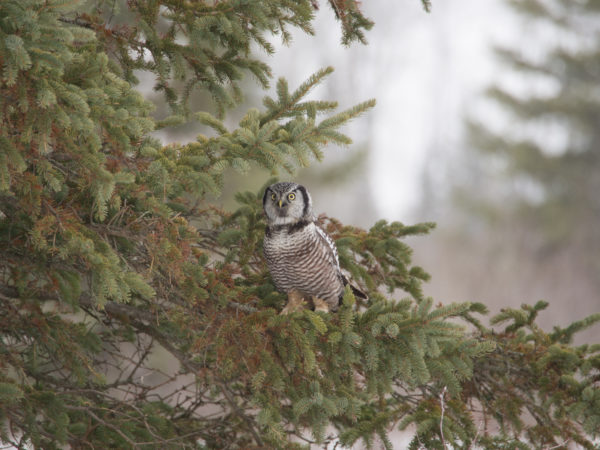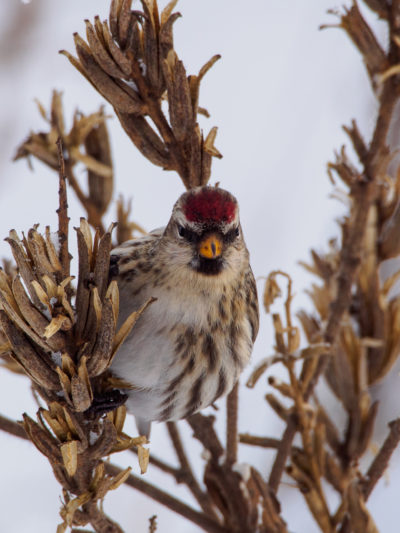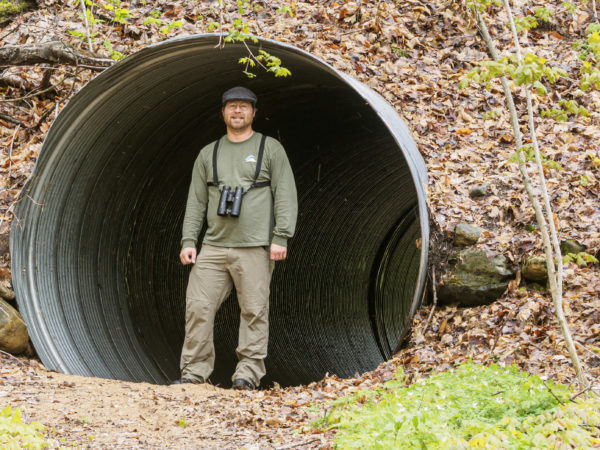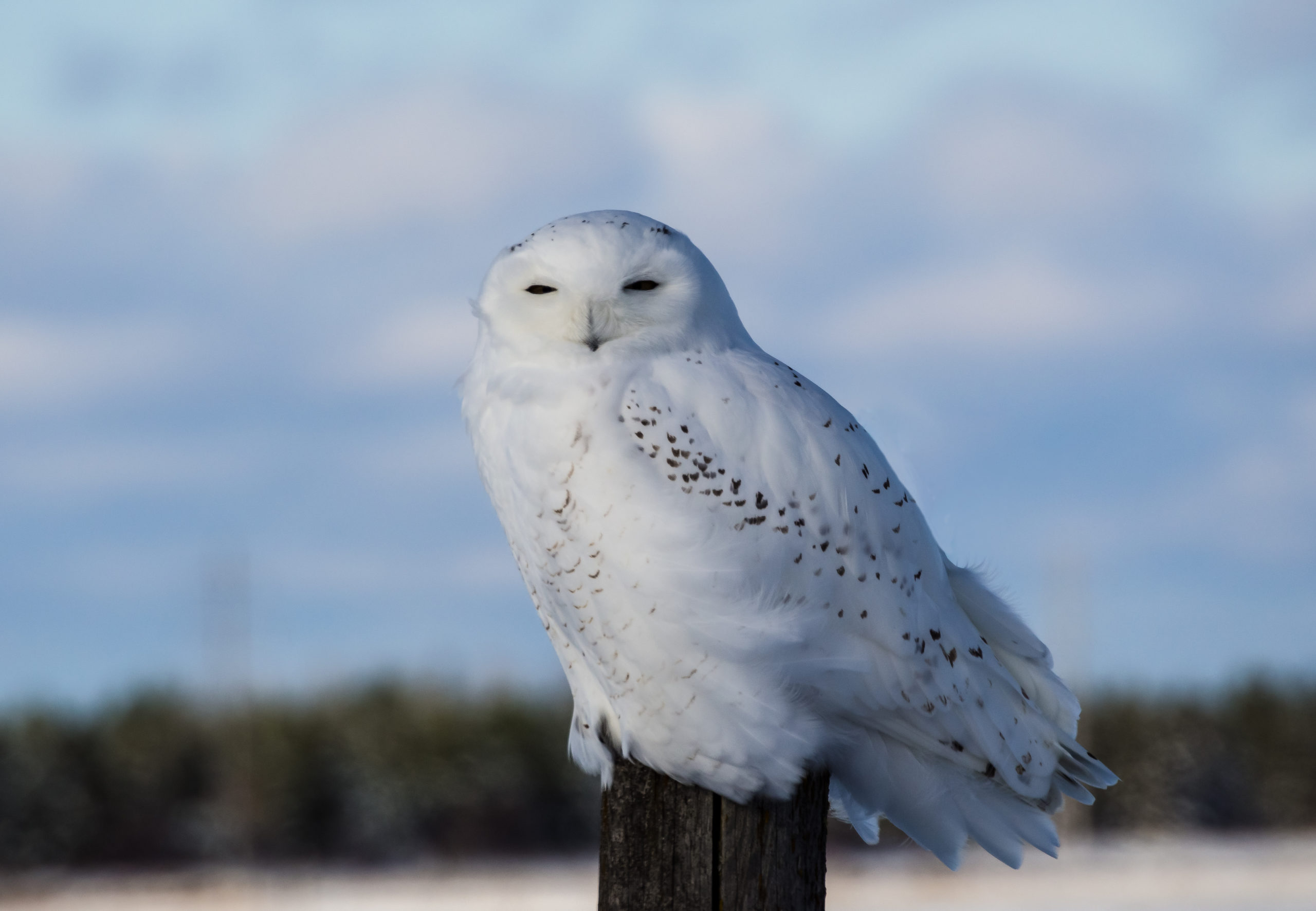I remember around eight years ago, when I first caught wind of this thing called birding, chasing a Eurasian Wigeon that had made its way to Nayanquing Point. I had watched the movie Big Year solely because of the actors in it but wondered if people really did stuff like that. A few internet searches later, I learned that yes, birding was a thing. I also learned that there was a Eurasian Wigeon a few hours’ drive from my home. Despite having never heard of the species before, I picked up cheap binoculars at Walmart (not recommended) on my way down, and thanks to some helpful birders with better optics, I was able to see the bird.

Northern Hawk Owl. Photo by Darrell Lawson
That summer, I spent quite a bit of time noticing the birds around me that I never had before, even though I grew up in Northern Michigan. The sense of discovery was amazing. It seemed like every day I was finding “new” birds. But things really became interesting when I took my first winter trip to the Eastern U.P. For some reason, those birds just resonated with me — species that come to Michigan some years and skip others. Every winter would be a different experience! I loved seeing species like Rough-legged Hawk, Northern Shrike, Pine Grosbeak, Common Redpoll, Pine Siskin, and Purple Finch for the first time. It seemed like every trip yielded something new. And there was always the possibility for something truly exciting — a Great Gray Owl, Northern Hawk Owl, or Gyrfalcon. It was during that first winter in the Eastern U.P. that I really fell in love with birding.
Eight years later, I rarely see new birds in Michigan. Instead of finding new life birds for myself on these winter trips, I am usually helping others to do so, including as a guide on the biannual Michigan Audubon winter birding tours in the Eastern U.P. I have led these trips since 2015, but due to the COVID-19 pandemic, they are canceled this winter. So, Michigan Audubon and I decided that I should write this guide to help those who may wish to visit the area this winter on their own. It should be well worth your time to do so — many of the species that we normally target on these trips are around in higher-than-usual numbers this year! So join me in as I “walk” you through birding the area in general and then focus on a few “can’t miss” spots.
 General Birding
General Birding
The area I will be focusing on is south of Sault Saint Marie, west to the Rudyard area, south to Pickford, and east to the shoreline, as this is where we typically focus our efforts during the birding tours. I usually crisscross roads to see what I can find while avoiding the highways because of traffic. Many of the roads are dead ends, though, so pay attention to signs and bring a good road atlas. Also, I know it can be exciting to see new birds, but remember before stopping to be courteous to other drivers. Pull far enough off the road to not obstruct traffic, and be aware that many of the ditches can be deceptively deep when covered with snow. Getting stuck is a great way to ruin your day of birding. Indoor restroom opportunities are limited, so you may want to show some restraint with your morning coffee. And I really want to stress, please be respectful of the birds and give them space. Don’t get so close as to stress them out or interfere with whatever they happen to be doing at that time.
As you are driving around, fields and sparsely wooded areas can be opportunities to find species such as Snowy Owl, Rough-legged Hawk, Northern Shrike, and Sharp-tailed Grouse. In wooded areas, look for many of the winter finches such as Pine Grosbeak, Evening Grosbeak, Purple Finch, Pine Siskin, and crossbills. Houses with feeders tend to attract many of the same finches but also may contain Common Redpoll and, rarely, a Hoary Redpoll. Fruit trees will attract Pine Grosbeak, Evening Grosbeak, and Bohemian Waxwing. This tends to be better earlier in the season as the fruit can already be thoroughly picked through by late winter.
Rudyard Loop
This is an area just east of Rudyard demarcated by Centerline Road to the west, South Hantz Road to the east, C48/19 Mile to the north, and C48 again to the south, and is bisected by I-75. Driving this loop typically yields Snowy Owl — sometimes over a dozen. But also, be on the lookout for Rough-legged Hawk hunting over the fields or sitting on telephone poles and fence posts. Snow Bunting are reliably found near, or on top of, a home between the I-75 overpass and Hantz Road along the southern section of C48.
Pickford
The town of Pickford features many fruit trees that attract birds. In addition, there are many fields and open areas nearby. I remember once setting up my scope in an intersection just a couple of miles outside of town. With a single 360-degree sweep, I was able to count 17 Snowy Owl from that single location. It is definitely worth spending time in this area.

Common Redpoll. Photo by Darrell Lawson
Dunbar Park
This location, at the mouth of the Charlotte River, can be a one-stop-shop for winter finches. The snow can get deep, and the road into the park is usually not plowed, but there are numerous fruit trees in the park itself that are always worth checking. Early in the season, before the rivers and lakes freeze over, Tundra Swan can be seen staging by the hundreds in the distance. But the real attraction is a short walk up South Scenic Drive to the west from the park. Here, there is a home with many, many feeders. Nearly any winter finch in the area will come to these feeders. It is worth spending some time here. It is also a nice gesture to leave a small bag of sunflower seed next to the garage.
9 Mile and Nicolet
Just east of the intersection of 9 Mile and Nicolet, along the north side of 9 Mile, there is a group of feeders alongside the road. In the early morning, this can be a reliable location to see Sharp-tailed Grouse. If not present there, drive west along 9 Mile toward Ridge Road. Sharp-tailed Grouse can be frequently seen in this area, but be cautious with your identification as Ruffed Grouse frequent this area as well.
This is just a small sampling of the great locations to look for birds in the area. For more locations and information, be sure to visit northhuronbirding.com. I hope you will get the opportunity to make a trip this year and experience the magic of winter birding in the Eastern U.P. for yourself.
~by Darrell Lawson, vice-president Petoskey Regional Audubon Society
This article appeared in the 2021 Winter Jack Pine Warbler.

Darrell is a past president (and current vice-president) of the Petoskey Regional Audubon Society, co-chaired the Sunset Coast Birding Trail development team, and is a current member of the Michigan Bird Records Committee. He routinely leads field trips around Michigan.

